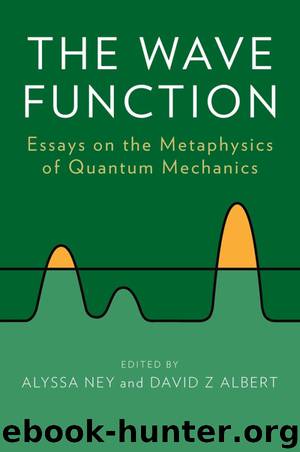The Wave Function: Essays on the Metaphysics of Quantum Mechanics by Alyssa Ney & David z Albert

Author:Alyssa Ney & David z Albert
Language: eng
Format: azw3
ISBN: 9780199790807
Publisher: Oxford University Press
Published: 2013-04-07T16:00:00+00:00
Rather than specifying the coordinates by choosing 3N axes, we choose three—the x-, y-, and z-axis, which are the same for each triple. That is, x1 through xN pick out points on the same axis, and similarly for y and z. Then the wave function can be regarded as a function of these parameters—as a mathematical entity inhabiting a (3 × N)-dimensional configuration space, rather than a 3N-dimensional plain space. And the basic thesis of wave function realism is that the world has this structure—the structure of a function on (3 ᅲ N)-dimensional configuration space.
Given that configuration space has this structure, an Albert-style appeal to dynamics to generate three-dimensional appearance is impossible, but it is also unnecessary. It is impossible because the Hamiltonian takes exactly the same form under every choice of coordinates, so no choice makes it especially simple. It is unnecessary because the outcome of that argument—that the coordinates are naturally grouped into threes—is built into the structure of reality, and hence doesn’t need to be generated as a mere appearance based on the simplicity of the dynamics.
4 Dimension without Illusion
The proposal of the previous section is designed to allow us to say that the world of quantum mechanics really is three-dimensional, and hence the three-dimensionality of appearances does not have to be generated as any kind of illusion. Our appearances are veridical. But does the proposal really allow us to do that? The wave function is still a function of 3N independent parameters, even if those parameters have some internal structure. Isn’t that a prima facie reason to say that the wave function—and hence the world—is 3N-dimensional?
Previously, I took the lesson here to be that the term dimension is ambiguous in the quantum mechanical world (Lewis 2004). One can take it to refer to the number of independent parameters required to specify a point in the space in which the quantum state evolves, or one can take it to refer to the number of independent axes required to impose coordinates on the space. In the classical case, these two coincide; a point in the space in which the classical state evolves is specified by three parameters, and imposing coordinates on the space requires three axes. But in the quantum case, the two dimension concepts come apart; it takes 3N parameters to specify a point in the space in which the wave function evolves, but only three axes are required to impose coordinates on this space. Hence, if quantum mechanics is true, there is a sense in which the world is 3N-dimensional and a sense in which it is three-dimensional. Under the latter sense, the apparent three-dimensionality of the world is no illusion.
My 2004 position is essentially the same as the one Albert adopts in the coda to his 1996 paper (although our reasons for adopting the position are different). Albert restates his thesis “a bit more diplomatically” (1996, p. 282). The diplomatic version of his thesis is that there are “two ideas we’re accustomed to having in mind when we think of ‘physical space.
Download
This site does not store any files on its server. We only index and link to content provided by other sites. Please contact the content providers to delete copyright contents if any and email us, we'll remove relevant links or contents immediately.
Enlightenment Now: The Case for Reason, Science, Humanism, and Progress by Steven Pinker(7228)
A Journey Through Charms and Defence Against the Dark Arts (Harry Potter: A Journey Through…) by Pottermore Publishing(4781)
The Immortal Life of Henrietta Lacks by Rebecca Skloot(4525)
A Journey Through Divination and Astronomy by Publishing Pottermore(4344)
Elon Musk by Ashlee Vance(4028)
Origin Story: A Big History of Everything by David Christian(3648)
COSMOS by Carl Sagan(3554)
Alchemy and Alchemists by C. J. S. Thompson(3449)
Bad Pharma by Ben Goldacre(3355)
Enlightenment Now by Steven Pinker(3335)
Shadow of Night by Deborah Harkness(3302)
Inferior by Angela Saini(3276)
A Mind For Numbers: How to Excel at Math and Science (Even If You Flunked Algebra) by Barbara Oakley(3217)
Origin Story by David Christian(3147)
The Code Book by Simon Singh(3074)
Signature in the Cell: DNA and the Evidence for Intelligent Design by Stephen C. Meyer(3071)
The Elements by Theodore Gray(2998)
A Brief History of Time by Stephen Hawking(2960)
A Journey Through Potions and Herbology (A Journey Through…) by Pottermore Publishing(2826)
